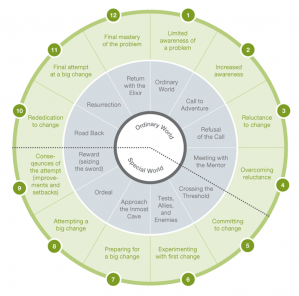I’m a stubborn fellow with a lot of books on my wish list, so I’ll often need to have a book recommended 3-4 times before I get it pushed to the top of the pile. That was the case with a book on public speaking called Resonate, by Nancy Duarte. It didn’t hurt that it was, and still is, offered for free via Apple iBooks.
She begins by describing the common arc of the Hero’s Journey, first developed by Joseph Campbell, found in so much of our classic literature and contemporary screenplays. Duarte has created a helpful schematic of that journey which looks like this:

The hero goes on a journey that transforms them into a better self. Duarte describes how a good presentation will be developed with this journey in mind, and in particular, the movement from step 4 to step 5:
“If the audience is the hero in your story, then the objective during your presentation is to get them past the fourth step in the wheel. Your presentation takes them to the threshold, but it’s their choice whether to cross it or not.”
The goal of preaching isn’t to make someone feel like they are the hero of the story, but her idea of moving someone toward transformation and growth is critical. This is a compelling idea that I’ve tried to keep in mind while forming my sermons together. And it will be a helpful foundation as we talk about how we put sermons together in the remaining posts in this series on Sermon Prep for the Missional Church Planter.
So far, I’ve written much about how to cultivate and capture ideas while on the go. The life of a church planter is one where we often won’t have as much time and attention to give to writing sermons as those in more established churches, and so I’ve focused a lot on how we can have practices that help us develop sermons as we go.
But, of course, there is a time when we have to settle in and do the hard work of engaging the Scriptures to be preached. To get all proverbial, much of what we’ve talked about so far is the inspiration bit, but there is also the perspiration part. Even a busy missional church planter will need hours set aside to allow the Spirit and text to form a sermon that will, in turn, form a people. So, today, we’ll talk about the need to Study, to sit with the passage(s) that we will construct a sermon around.
Finding a Rhythm
Of the 30 or so interviews I’ve done on Sermonsmith, there is one consistent theme I’ve seen: those who regularly prepare sermons have settled into some kind of regular rhythm. Few can take a full day to bang out a sermon, but most break up their sermon prep into chunks of time throughout the week.
By creating multiple spaces in our calendar each week, it allows us to focus on the Scripture we are preparing to preach while also stepping away from it to continue to work on us, ruminating with it while in the midst of our daily happenings. I personally find that protecting 1-3 hours spread out over 2-3 mornings early in the week (or even the week prior) gives me the best voyage through the text as I figure out what it has to say to me and then to our congregation.
Approaching the Text
The first step of study is to come toward the text and allow it to begin to speak for itself. Whether or not you are preaching through a theme, or actually preaching on a particular text, will have a good deal of influence on what your study looks like. I find that, even when doing a thematic series, I want to have a primary text or two that I’m going to develop, so I approach study with a chunk of text in mind.
It’s been an important reminder for me in my Sermonsmith interviews to hear how many try to move into the text devotionally before anything else. Whether that be creating space for Lectio Divina, or just asking “What does this text have to say to me?”, this allows us to engage Scriptures as sacred writings before we move into them as historical documents.
I also find a good first step before ask question of the text. I’ll sit with the passage in front of me, and a blank page, and start writing out questions as I read through the text. I try to ask questions as if I’m reading for the first time. It’s best to do this part of my study in a public space, usually a coffee shop, imagining what kinds of questions those around me might ask as they read this text. This helps me bring fresh eyes to the text, and helps me see things I might glaze over, especially in a text I’m more familiar with.
Another helpful kickstarter for asking questions is a document called A Thousand Questions to Ask the Text. It came from a Sermonsmith interview with Steve Carter of Willow Creek, and dates back to his time studying with Rob Bell. It’s really only 84 questions, but 84 good ones to help get you thinking about how to form a text into a sermon.
Hearing Other Voices
It’s helpful to sit with the text alone, and that’s an important place to start, but it shouldn’t be the extent of our study. It’s also critical to bring in other voices to the text to affirm our own direction is in line with scholarship and tradition and to build a wider base of understanding.Blocks of time should be designated to invite other voices to mingle with our own reflections on a text.
Deep interaction with a text through diagramming, word studies or journal articles is always good. But if you are a church planter with limited amounts of time available, commentaries offer the most impact for building an understanding of a text. A good commentator will offer you the fruit of her own deep interactions with the text.
It’s important to have a mix of commentaries for any text, and here are two sites I often consult when I need commentaries:
- BestCommentaries.com—an online catalog and rating of commentaries by series or text\
- Scot McKnight’s Commentary recommendations —a listing to the recommendations Scot has for each book of the NT
I recognize why some prefer engaging with physical books, but I recommend any church planter invest or raise funds for good Bible software. The ability to have a large library available with cross linking of resources is a rich tool for study anywhere. The two that get the most mentions in my conversations with preachers are Accordance and Logos because they are accessible from multiple platforms and devices. (Logos is my favorite, and for full disclosure, I should mention that Logos link goes to my Sermonsmith partnership page which includes a 15% discount offer on a base package.)
Having Something to Say
Before I move on from the study portion of my sermon prep, I want to know that I have something to say. I want to see the ancient movement of a text toward God’s redemptive work, and capture how it still moves today. I want to see something in a text that shapes and excites me so I can invite others into that journey too; not a hero’s journey, but a transforming trek into the Kingdom of God.
“How can I become a V3 Church Planter?”
Image credit Duarte, Thierry E.
Share on Facebook
Share on Twitter
Share this Post

